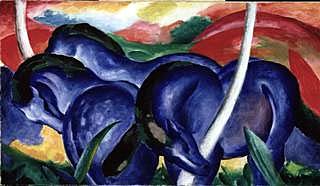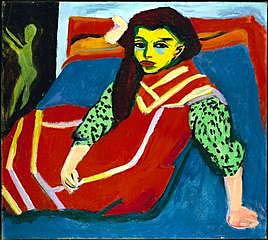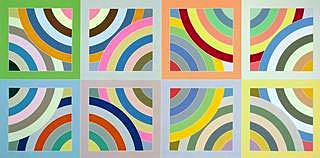 |
 |
 |
 |
 |
When small dots of pure color are applied close together, the viewer's eyes mix the colors. Notice that each dot of
pure color the artist has used looks bright, but when your eye mixes them they are subdued, almost neutral. |
 |
Georges Seurat
Port-en-Bessin
1888
Oil on canvas
The Minneapolis Institute of Arts
The William Hood Dunwoody Fund

|
|
 |
 |
 |
 |
 |
|
 |
 |
 |
 |
 |
When small dots of pure hue are applied close together, the viewer's eyes mix these hues. Notice the brightness of the
pure hues the artist has used. |
 |
Georges Seurat
Detail of Port-en-Bessin
1888
Oil on canvas
The Minneapolis Institute of Arts
The William Hood Dunwoody Fund

|
|
 |
 |
 |
 |
 |
|
 |
 |
 |
 |
 |
Some artists use color in an arbitrary way. Instead of imitating the natural colors of objects, they used colors for
symbolic or expressive purposes. In this painting the artist selected colors that symbolized universal principles such as spiritual
harmony with nature, not the colors he really saw. |
 |
Franz Marc
Die grossen blauen Pferde (The Large Blue Horses)
1911
oil on canvas
Walker Art Center
Gift of the T. B. Walker Foundation, Gilbert M. Walker Fund

|
|
 |
 |
 |
 |
 |
|
 |
 |
 |
 |
 |
In this painting the artist also selected colors for expressive purposes. Notice that all of the primary colors (red,
blue and yellow) and secondary colors (green, orange and violet) have been used. |
 |
Ernst Ludwig Kirchner
Seated Girl (Fränzi Fehrmann)
1910; altered 1920
Oil on canvas
The Minneapolis Institute of Arts
The John R. Van Derlip Fund

|
|
 |
 |
 |
 |
 |
|
 |
 |
 |
 |
 |
In this painting shapes merely suggest natural objects and colors are applied scientifically, the way notes form chords in
musical compositions. Orange, green, and purple - the three secondary colors - form a "dominant chord" that produces, according
to the artist's theories, a feeling of harmony in the viewer. |
 |
Stanton Macdonald-Wright
Synchromy in Green and Orange
1916
oil on canvas
Walker Art Center
Gift of the T. B. Walker Foundation, Hudson D. Walker Collection

|
|
 |
 |
 |
 |
 |
|
 |
 |
 |
 |
 |
In this painting the artist has used colors simply for the way in which they react with one another. Notice the
intense red semi-circle and how it advances toward the viewer. The less intense colors seem to recede. Here, color creates
movement! |
 |
Frank Stella
Tahkt-I-Sulayman Variation II
1969
Acrylic on canvas
The Minneapolis Institute of Arts
Gift of Bruce B. Dayton

|
|
 |
 |
 |
 |
 |









